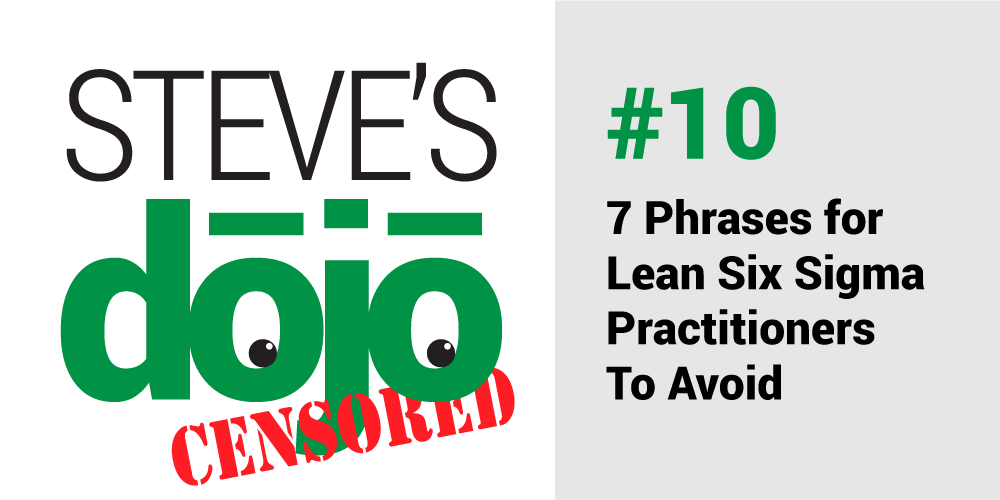am borrowing from Lake Superior State University’s annual list of words and phrases it has banished. There are other such lists...Some are epic, others awesome sauce, a few impactful.
Here are mine:
1. Idiot-proof
I haven’t railed against this term in years but I heard it the other day within our walls (and it inspired today’s post). I like to think our entire institution is idiot-proof. We don’t hire idiots. This term is often used in reference to forcing functions, as in, “We’ll make the process idiot-proof with forcing functions.” In a safety culture, forcing functions are for everyone because anyone can experience a cognitive lapse at an unfortunate moment. If you use “idiot-proof,” put yourself in time-out.
2. “We’ve always done it this way.”
In my 20+ years as a LSS practitioner, no one has ever said this to me as an earnest defense of unrelenting inertia. I’ve only ever heard it attributed to faceless, obstinate others. And that’s because no one ever says it. Ascribing, “We’ve always done it this way,” to the owners of the current state is mildly condescending. There’re always reasons a process developed into its current state. This is the principle summarized by Chesterton’s fence: Someone put this fence here for a reason; before removing it, strive to understand the reason. Maybe it was holding in a flock of rabid penguins. If the frothing flightless flock in formal wear have all died off, remove it, but maybe they’re still hiding in the tree line, waiting for you.
3. Should
Hat tip to Chrissy Daniels on calling me out on this one. I’m still trying to break the habit. Should portends a commandment. It’s a more polite thou shalt. Give the reader/listener a compelling reason. If you’re speaking and should slips out, immediately follow it with a compelling reason. If you’re writing, explain the compelling reason and drop should altogether. If you don’t have a compelling reason, revisit the vision summary; it’s your guide to compelling reasons.
4. Countless (and its innumerable cousins)
Countless has a confidence interval of zero to infinity. We’re in the quantification business. We can narrow it down from countless . I read that putting your baby in a laundry basket while in the tub, “will save countless babies from drowning.” Wrong. It took me under two minutes to get the real estimate: 58/year.
5. Front lines
The context is usually something like, “When improving value, go talk to the people on the front lines.” Work isn’t war. Providers, nurses, HCAs, and MAs aren’t in the infantry. Patients, family, “the system” aren’t enemy combatants. Substitute with “people doing the work.”
6. “Does that make sense?”
If you have to ask...Don’t toss together a word salad and then put the listener/reader in the position of admitting/denying they didn’t understand. Take the time to make sure it makes sense to begin with.
7. Straw man
This one’s not a terribly big deal. I often hear straw man as a metaphor for an outline or a sketch of a nascent idea. The (minor) problem is that a straw man is a dishonest political technique intended to misrepresent an opposing message or idea. It usually starts out, “Some people say…” but those people don’t really exist. You build a straw man with a silly or offensive message because it’s easy to topple it. It can’t defend itself. You might confuse someone by using this phrase.
Steve Johnson
If in previous dojo posts, you still haven’t found what you’re looking for, today’s post will satisfy your desire. In it we describe the mysterious ways of Drs. Chris Hull’s and Mark Eliason’s clinic practice. Unless you’re a patient, you can’t witness their clinic, but this post is even better than the real thing.
Standard work is a visual guide to accomplish a job quickly and accurately. We asked our resident etiquette expert, Patient Advisor Mary Martha Tripeny, to put this Lean tool to the test by creating standard work for thank you notes. The holidays are stressful enough. This year, when nagging your children to write thank you notes, give Mary Martha’s standard work a try.
Hospitalist Ryan Murphy introduces quality improvement (QI): The systematic and continuous approach to improvement.
